|
|
 |
|
Calanoida ( Order ) |
|
|
|
Calanoidea ( Superfamily ) |
|
|
|
Paracalanidae ( Family ) |
|
|
|
Calocalanus ( Genus ) |
|
|
| |
Calocalanus styliremis Giesbrecht, 1888 (F,M) | |
| | | | | | | Syn.: | no Calocalanus styliremis : Bradford, 1972 (p.34, figs.F);
Calocalanus styliremis s.l. : Brinton & al., 1986 (p.228, Table 1); | | | | Ref.: | | | Giesbrecht, 1892 (p.176, 185, 770, figs.F,M); Giesbrecht & Schmeil, 1898 (p.26, Rem. F,M); Farran, 1908 b (p.22); Früchtl, 1923 a (p.149, figs.F, Rem.); Sars, 1925 (p.27); Farran, 1926 (p.234, figs.F, Rem.); 1929 (p.208, 222); Sewell, 1929 (p.89); Rose, 1933 a (p.76, figs.F,M); Hardy & Gunther, 1935 (p.147); Farran, 1936 a (p.83); Wilson, 1942 a (p.173, figs.juv.M; Vervoort, 1946 (p.138); Farran & Vervoort, 1951 d (n°36, p.3, figs.F) Tanaka, 1956 c (p.379, figs.F); 1960 (p.30); Bernard, 1960 (n°36 first revision, p.4, figs.F); Vervoort, 1963 b (p.114: as C. styliremus, Rem.); Tanaka, 1964 (p.6); Chen & Zhang, 1965 (p.45, 130: Rem., figs.F); Corral Estrada, 1970 (p.117, figs.F, M, Rem.); Björnberg, 1972 (p.20, figs.N, Rem.N); Bradford, 1972 (p.34, figs.F); Razouls, 1972 (p.94, Annexe: p.23, figs.F); Corral, 1972 b (n°138, p.4, 5, figs.F,M); Chen & Zhang, 1974 (p.108, figs.M); Dawson & Knatz, 1980 (p.4, figs.F,M); Björnberg & al., 1981 (p.604, 624, figs.F,M); Gardner & Szabo, 1982 (p.164, figs.F,M); Zheng & al., 1982 (p.26, Fig.F); Sazhina, 1985 (p.42, figs.N); Bradford-Grieve, 1994 (p.64, figs.F,M, fig.99); Chihara & Murano, 1997 (p.750, Pl.71: F,M); Bradford-Grieve & al., 1999 (p.877, 909, figs.F,M); Conway & al., 2003 (p.203, figs.F,M, Rem.); Boxshall & Halsey, 2004 (p.154: figs.F,M); Avancini & al., 2006 (p.72, Pl. 41, figs.F,M, Rem.); Vives & Shmeleva, 2007 (p.958, figs.F,M, Rem.) | 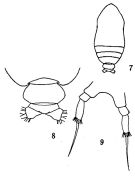 issued from: Q.-c Chen & S.-z. Zhang in Studia Marina Sinica, 1965, 7. [Pl.10, 7-9]. Female (from E China Sea): 7, habitus (dorsal); 8, urosome (dorsal); 9, P5 (posterior).
|
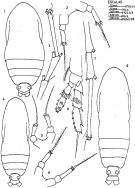 issued from : J. Corral Estrada in Tesis Doct., Univ. Madrid, A-129, Sec. Biologicas, 1970. [Lam.28]. Female (from Canarias Is.): 1, habitus (dorsal); 2, distal segments of A1; 3, P5; 4, habitus (dorsal, another specimen); 5, P5; 6, habitus (dorsal, another individual); 7, distal segments of A1; 8, P4; 9, P5.
|
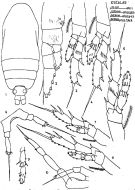 issued from : J. Corral Estrada in Tesis Doct., Univ. Madrid, A-129, Sec. Biologicas, 1970. [Lam.29]. Female: 1, habitus (dorsal); 2, P1; 3, P2; 4, P3; 5, P4; 6, P5. Male: 7, P2; 8, P3; 9, endopodal segments of P4; 10, P5.
|
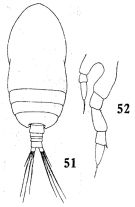 issued from : Q.-c. Chen & S.-z. Zhang in Studia Marina Sinica, 1974, 9. [Pl.5, Figs. 51-52]. Male (from South China): 51, habitus (dorsal); 52, P5.
|
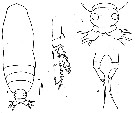 issued from : Z. Zheng, S. Li, S.J. Li & B. Chen in Marine planktonic copepods in Chinese waers. Shanghai Sc. Techn. Press, 1982 [p.27, Fig.14]. Female: a, habitus (dorsal); b, urosome (dorsal); c, P4; d, P5. Scale in mm.
|
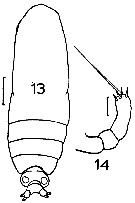 issued from : J.M. Bradford in Mem. N. Z. Oceonogr. Inst., 1972, 54. [p.35, Fig.5 (13-14)]. Female (from Kaikoura, New Zealand): 13, habitus (dorsal); 14, P5. Scale bars: 1 mm (13); 0.01 mm (14).
|
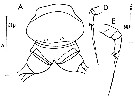 issued from : C. Razouls in Th. Doc. Etat Fac. Sc. Paris VI, 1972, Annexe. [Fig.27, A, D-E]. Female (from Banyuls, G. of Lion): A, urosome; D-E, P5 (from two specimens)
|
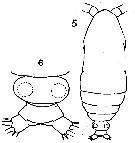 issued from : G.P. Farran in Biscayan Plankton collected during a Cruise of H.M.S. 'Research', 1900.- Part XIV. The Copepoda. (Linn. Journ. Zoology, XXXVI, 1926). [p.303, Pl.5, Figs.5-6]. Female: 5, habitus (dorsal); 6, urosome (dorsal).
|
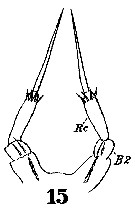 Issued from : W. Giesbrecht in Systematik und Faunistik der Pelagischen Copepoden des Golfes von Neapel und der angrenzenden Meeres-Abschnitte. – Fauna Flora Golf. Neapel, 1892, 19 , Atlas von 54 Tafeln. [Taf.9, Fig.15]. Female: 15, P5 (anterior view).
|
 Issued from : W. Giesbrecht in Systematik und Faunistik der Pelagischen Copepoden des Golfes von Neapel und der angrenzenden Meeres-Abschnitte. – Fauna Flora Golf. Neapel, 1892, 19 , Atlas von 54 Tafeln. [Taf.9, Fig.18]. Female: 18, distal segments of A1.
|
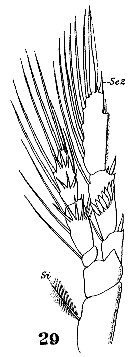 Issued from : W. Giesbrecht in Systematik und Faunistik der Pelagischen Copepoden des Golfes von Neapel und der angrenzenden Meeres-Abschnitte. – Fauna Flora Golf. Neapel, 1892, 19 , Atlas von 54 Tafeln. [Taf.9, Fig.29]. Female: 29, P4 (posterior view).
|
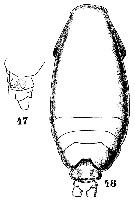 Issued from : W. Giesbrecht in Systematik und Faunistik der Pelagischen Copepoden des Golfes von Neapel und der angrenzenden Meeres-Abschnitte. – Fauna Flora Golf. Neapel, 1892, 19 , Atlas von 54 Tafeln. [Taf.36, Figs.47, 48]. Female: 47, last thoracic segment with P5 and urosome (lateral); 48, habitus (dorsal).
|
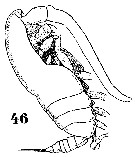 Issued from : W. Giesbrecht in Systematik und Faunistik der Pelagischen Copepoden des Golfes von Neapel und der angrenzenden Meeres-Abschnitte. – Fauna Flora Golf. Neapel, 1892, 19 , Atlas von 54 Tafeln. [Taf.36, Fig.46]. Male: 46, habitus (lateral).:
|
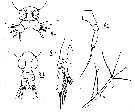 Issued from : M. Bernard in Bull. Soc. Zool. France, 1958, 83. [p.189, Figs. 6 a, b, 7, 8 a, b]. Calocalanus styliremis (from Alger Bay, Algeria): 6a, P5; 6b, P4; 7, terminal segments of A1; 8a-8b, urosome (two aspects). Lengths: Urosome: 0.150 mm.
|
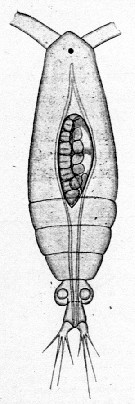 Issued from : E. Chatton in Arch. Zool. Exp. & Gen., 1920, 59, [p.122, Fig.23]. Calocalanus styliremis female (from Banyuls) parasited by Blastodinium crassum (Dinoflagellate). Nota: The infestation index shows that the species is weak by comparison with Paracalanus parvus and Clausocalanus furcatus, but the latters very much abundant in the samples.
|
 Issued from : E. Chatton in Arch. Zool. Exp. & Gen., 1920, 59, [p.178, Fig.81]. Calocalanus styliremis female (from Banyuls) parasited by Blastodinium contortum (Dinoflagellate), very twisted in the copepod's gut.
| | | | | Compl. Ref.: | | | Pearson, 1906 (p.9); Chatton, 1920 (p.17, parasite); Rose, 1925 (p.151); Hardy & Gunther, 1935 (1936) (p.147, Rem.); Sewell, 1948 (p.323, 381, 391, 395, 407, 414, 453, 460, 462, 468, 469, 473, 477, 478, 481, 493); C.B. Wilson, 1950 (p.180); Yamazi, 1958 (p.148, Rem.); Fagetti, 1962 (p.13); Grice & Hart, 1962 (p.287, 293: Rem.); Gaudy, 1962 (p.93, Rem.: p.104); Duran, 1963 (p.14); V.N. Greze, 1963 a (tabl.2); Shmeleva, 1963 (p.141); Ahlstrom & Thrailkill, 1963 (p.57, Table 5, abundance); Grice, 1963 a (p.495); Björnberg, 1963 (p.30, Rem.); De Decker, 1964 (p.15, 18, 29); De Decker & Mombeck, 1964 (p.11); Grice & Hulsemann, 1965 (p.223); Shmeleva, 1965 b (p.1350, lengths-volume -weight relation); Neto & Paiva, 1966 (p.21, Table III); Mazza, 1966 (p.69); 1967 (p.355: Rem.); Pavlova, 1966 (p.43); Grice & Hulsemann, 1967 (p.14); Fleminger, 1967 a (tabl.1); De Decker, 1968 (p.45); Park, 1970 (p.475); Deevey, 1971 (p.224); Carli, 1971 (p.372, tab.1); Apostolopoulou, 1972 (p.327, 340); Binet & al., 1972 (p.71); Roe, 1972 (p.277, tabl.1, tabl.2); Bainbridge, 1972 (p.61, Appendix Table I: vertical distribution vs day/night, as sryliremus); Björnberg, 1973 (p.308, 384); Corral Estrada & Pereiro Muñoz, 1974 (tab.I); de Bovée, 1974 (p.109, 124); Vives & al., 1975 (p.35, tab.II, III, IV); Peterson & Miller, 1976 (p.14, Table 1, 3, abundance vs interannual variations); 1977 (p.717, Table 1, seasonal occurrence); Deevey & Brooks, 1977 (p.256, tab.2, Station "S"); Carter, 1977 (1978) (p.35); Comaschi Scaramuzza, 1978 (p.17); Vaissière & Séguin, 1980 (p.23, tab.1); Kovalev & Schmeleva, 1982 (p.83); Brenning, 1982 (p.5, spatial distribution, T-S diagram, Rem.); Vives, 1982 (p.290); De Decker, 1984 (p.315, 334: chart); Guangshan & Honglin, 1984 (p.118, tab.); Roe, 1984 (p.356); Scotto di Carlo & al., 1984 (1042); Brenning, 1985 a (p.24, Table 2); Moraitou-Apostolopoulou, 1985 (p.303, occurrence/abundance in E Mediterranean Sea, Rem.: p.310); Regner, 1985 (p.11, Rem.: p.25); Almeida Prado Por, 1985 (p.250); Comaschi Scaramuzza, 1987 (tab.1); Lozano Soldevilla & al., 1988 (p.57 as stylimeris); McKinnon, 1991 (p.471); Shih & Marhue, 1991 (tab.2, 3); Seguin & al., 1993 (p.23, 26: Rem.); Oliveira Dias, 1995 (p.147); Shih & Young, 1995 (p.71); Hajderi, 1995 (p.542); Siokou-Frangou, 1997 (tab.1); Hure & Krsinic, 1998 (p.100); Noda & al., 1998 (p.55, Table 3, occurrence); Lopes & al., 1998 (p.195); Suarez-Morales & Gasca, 1998 a (p108); Seridji & Hafferssas, 2000 (tab.1); Lavaniegos & Gonzalez-Navarro, 1999 (p.239, Appx.1); Razouls & al., 2000 (p.343, Appendix); Ueda & al., 2000 (tab.1); d'Elbée, 2001 (tabl. 1); Holmes, 2001 (p.38); Peterson & al. 2002 (p.381, Table 2, interannual abundance); Zerouali & Melhaoui, 2002 (p.91, Tableau I); Bode & al., 2003 (p.85, Table 1, abundance); Peterson & Keister, 2003 (p.2499, interannual variability); Keister & Peterson, 2003 (p.341, Table 1, abundance, cluster species vs hydrological events); Vukanic, 2003 (139, tab.1); Hsieh & al., 2004 (p.397, tab.1); Rezai & al., 2004 (p.490, tab.2, comme styliformis); Lan & al., 2004 (p.332, tab.1); Fernandez de Puelles & al., 2004 (p.654, fig.7); Lo & al., 2004 (p.89, tab.1); Fernandez & al., 2004 (p.501, tab.5); Rezai & al., 2005 (p.157, Table 5: spatial & temporal variations); Isari & al., 2006 (p.241, tab.II); Fernandez de Puelles & al., 2007 (p.340: fig.7); Valdés & al., 2007 (p.103: tab.1); Dur & al., 2007 (p.197, Table IV); Khelifi-Touhami & al., 2007 (p.327, Table 1); McKinnon & al., 2008 (p.844: Tab.1); Cabal & al., 2008 (289, Table 1); Morales-Ramirez & Suarez-Morales, 2008 (p.518); Galbraith, 2009 (pers. comm.); Chiba & al., 2009 (p.1846, Table 1, occurrence vs temperature change); Licandro & Icardi, 2009 (p.17, Table 4); Lidvanov & al., 2010 (p.356, Table 3); Hidalgo & al., 2010 (p.2089, fig.4, Table 2, cluster analysis); Mazzocchi & Di Capua, 2010 (p.426); Medellin-Mora & Navas S., 2010 (p.265, Tab. 2); Fazeli & al., 2010 (p.153, Table 1); W.-B. Chang & al., 2010 (p.735, Table 2, abundance); Maiphae & Sa-ardrit, 2011 (p.641, Table 2, 3, Rem.); Isari & al., 2011 (p.51, Table 2, abundance vs distribution); Andersen N.G. & al., 2011 (p.71, Fig.3: abundance); Tutasi & al., 2011 (p.791, Table 2, abundance distribution vs La Niña event); Keister & al., 2011 (p.2498, interannual variation); Johan & al., 2012 (2013) (p.1, Table 1); Uysal & Shmeleva, 2012 (p.909, Table I); DiBacco & al., 2012 (p.483, Table S1, ballast water transport); Dorgham & al., 2012 (p.473, Table 3: abundance %); Hidalgo & al., 2012 (p.134, Table 2); Belmonte & al., 2013 (p.222, Table 2, abundance vs stations); Cornils & Blanco-Bercial, 2013 (p.861, Table 1, molecular analysis, figs.3, 4, 5); in CalCOFI regional list (MDO, Nov. 2013; M. Ohman, pers. comm.); Terbiyik Kurt & Polat, 2013 (p.1163, Table 2, seasonal distribution); Tachibana & al., 2013 (p.545, Table 1, seasonal change 2006-2008); Sobrinho-Gonçalves & al., 2013 (p.713, Table 2, fig.8, seasonal abundance vs environmental conditions); Lidvanov & al., 2013 (p.290, Table 2, % composition) ; Pansera & al., 2014 (p.221, Table 2, abundance); Mazzocchi & al., 2014 (p.64, Table 3, 4, 5, spatial & seasonal composition %); Zakaria, 2014 (p.3, Table 1, abundance vs 1960-2000); Zakaria & al., 2016 (p.1, Table 1);Benedetti & al., 2016 (p.159, Table I, fig.1, functional characters); Ben Ltaief & al., 2017 (p.1, Table III, Summer relative abundance); El Arraj & al., 2017 (p.272, table 2); Benedetti & al., 2018 (p.1, Fig.2: ecological functional group); Belmonte, 2018 (p.273, Table I: Italian zones); Chaouadi & Hafferssas, 2018 (p.913, Table II: occurrence); Palomares-Garcia & al., 2018 (p.178, Table 1: occurrence); Hirai & al., 2020 (p.1, Fig. 5: cluster analysis (OTU), spatial distribution). | | | | NZ: | 20 | | |
|
Distribution map of Calocalanus styliremis by geographical zones
|
| | | | | | | | | | | | | | |  issued from : A.A. Shmeleva in Bull. Inst. Oceanogr., Monaco, 1965, 65 (n°1351). [Table 6: 12 ]. Calocalanus styliremis (from South Adriatic). issued from : A.A. Shmeleva in Bull. Inst. Oceanogr., Monaco, 1965, 65 (n°1351). [Table 6: 12 ]. Calocalanus styliremis (from South Adriatic).
Dimensions, volume and Weight wet. Means for 50-60 specimens. Volume and weight calculated by geometrical method. Assumed that the specific gravity of the Copepod body is equal to 1, then the volume will correspond to the weight. |
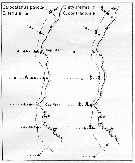 issued from : U. Brenning in Wiss. Z. Wilhelm-Pieck-Univ. Rostock - 31. Jahrgang 1982. Mat.-nat. wiss. Reihe, 6. [p.5, Fig.7]. issued from : U. Brenning in Wiss. Z. Wilhelm-Pieck-Univ. Rostock - 31. Jahrgang 1982. Mat.-nat. wiss. Reihe, 6. [p.5, Fig.7].
Spatial distribution for Calocalanus styliremis, C. contractus, C. pavo, C. tenuis from 8° S - 26° N; 16°- 20° W. |
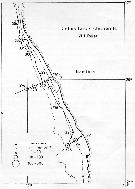 issued from : U. Brenning in Wiss. Z. Wilhelm-Pieck-Univ. Rostock - 31. Jahrgang 1982. Mat.-nat. wiss. Reihe, 6. [p.5, Fig.9]. issued from : U. Brenning in Wiss. Z. Wilhelm-Pieck-Univ. Rostock - 31. Jahrgang 1982. Mat.-nat. wiss. Reihe, 6. [p.5, Fig.9].
Spatial distribution for Calocalanus styliremis from Namibia, expedition VIII (21/9-17/12, 1976) |
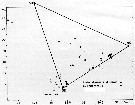 issued from : U. Brenning in Wiss. Z. Wilhelm-Pieck-Univ. Rostock - 31. Jahrgang 1982. Mat.-nat. wiss. Reihe, 6. [p.6, Fig.10]. issued from : U. Brenning in Wiss. Z. Wilhelm-Pieck-Univ. Rostock - 31. Jahrgang 1982. Mat.-nat. wiss. Reihe, 6. [p.6, Fig.10].
T-S diagram for Calocalanus styliremis, and Calocalanus contractus (all copepodid stages) from 8° S - 26° N; 16°- 20° W, and Namibia.
SO: Southern Surface Water (S °/oo: 34,50; T°C: 29,0); ND: Northern Water of the Surface Layer (S °/oo: 37,5; T°C: 21,0); SD: Southern Deep Water of the surface layer (S °/oo: 35,33; T°C: 13,4). See commentary in Temora stylifera and Brenning (1985 a, p.6).
Nota: This species is euryecological form. |
| | | | Loc: | | | Cosmopolite (tropical and temperate, World-wide), South Africa (E & W), also: sub-Antarct. (SW Atlant., N South Georgia, Indian), Bering Sea, Straits of Malacca, Malaysia (Sarawak: Bintulu coast), G. of Thailand, China Seas (East China Sea, South China Sea), Kuchinoerabu Is., Tokyo Bay, British Columbia, Oregon (off Newport), W Baja California, La Paz, Galapagos-Ecuador, Chile (S, off Santiago), Caribbean Colombia, Sargasso Sea, Station "S" (32°10'N, 64°30'W).
Data from Cornils & Blanco-Bercial (2013): 01°00'S; 09°00'W (W Guinea Basin). | | | | N: | 180 | | | | Lg.: | | | (14) F: 0,748-0,66; (34) F: 0,68-0,62; (35) F: 0,74-0,65; (38) F: 0,85-0,8; (47) F: 0,72-0,6; M: 0,55; (55) F: 0,69-0,6; 0,84-0,75; (66) F: 0,64; (114) F: 0,76; (116) F: 0,75; (199) F: 0,68-0,61; (237) F: 0,6-0,7; M: 0,65; (290) F: 0,8-0,6; (338) M: 0,55-0,45; (786) F: 0,68; (866) F: 0,5-0,9; M: 0,5-0,6; (991) F: 0,59-0,95; M: 0,48-0,55; (1023) F: 0,60-0,69; 0,75-0,84; (1112) F: 0,567-0,912 [NW Africa]; 0,72-0,816 [Namibia]; (1132) F: 0,62-0,72; M: 0,55; {F: 0,50-0,95; M: 0,45-0,65} | | | | Rem.: | epipelagic- mesopelagic. Sampling depth (Sub-Antarctic): 0-50 m. Sargasso Sea: 0-500 m (Deevey & Brooks, 1977, Station "S").For Bainbridge (1972, p.91) the species is epipelagic (day and night) on the African coasts of Gulf of Guinea.
Registered off the Brazilian coast for the first time by Björnberg (1963).
After Benedetti & al. (2018, p.1, Fig.2) this species belonging to the functional group 4 corresponding to small filter feeding herbivorous and mixed feeding omnivorous (mostly broadcasters).
See in DVP Conway & al., 2003 (version 1) | | | Last update : 25/10/2022 | |
|
|
 Any use of this site for a publication will be mentioned with the following reference : Any use of this site for a publication will be mentioned with the following reference :
Razouls C., Desreumaux N., Kouwenberg J. and de Bovée F., 2005-2025. - Biodiversity of Marine Planktonic Copepods (morphology, geographical distribution and biological data). Sorbonne University, CNRS. Available at http://copepodes.obs-banyuls.fr/en [Accessed October 21, 2025] © copyright 2005-2025 Sorbonne University, CNRS
|
|
 |
 |






















